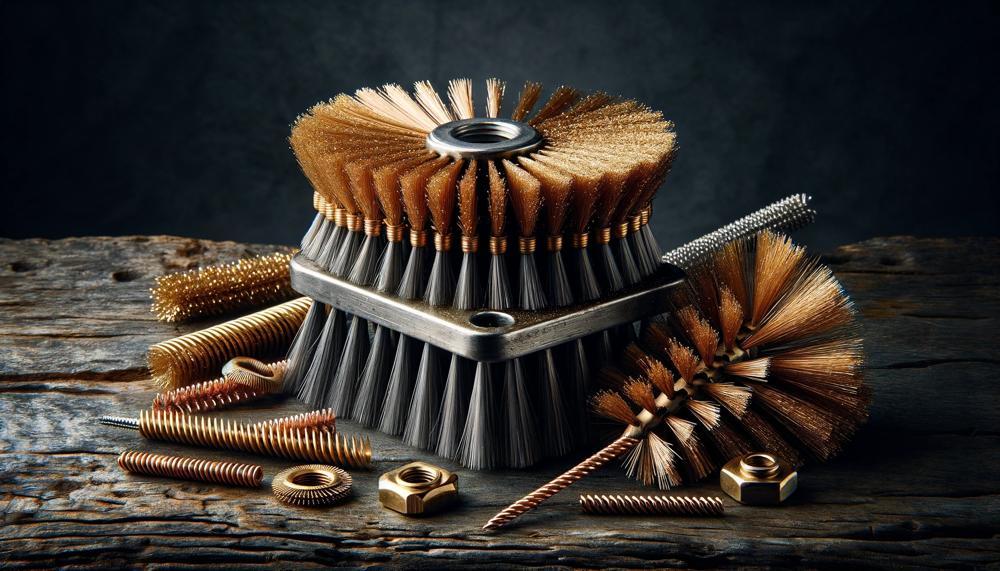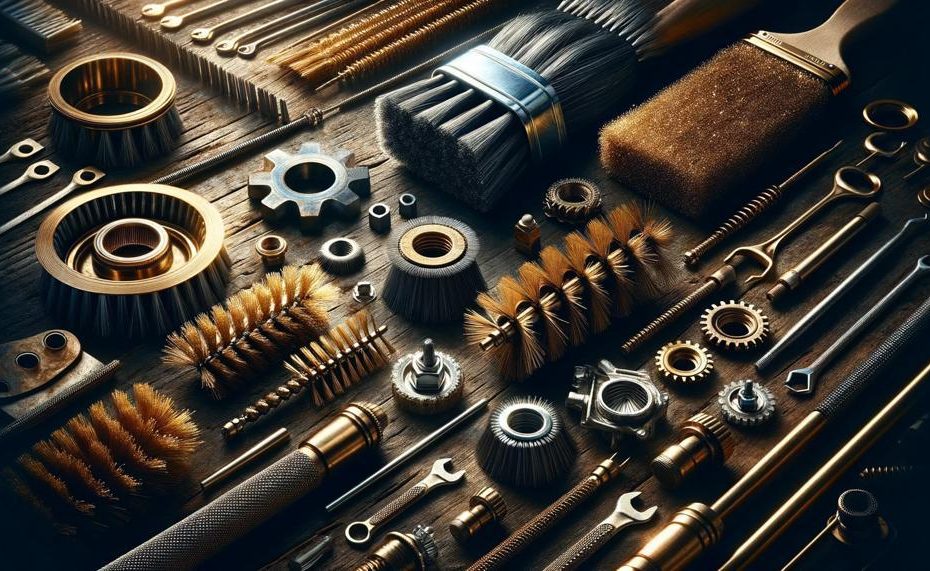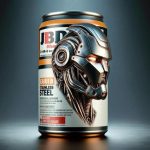In the realm of metalworking and restoration, the selection of tools may significantly impact the outcome of a job. Using a brass wire brush on aluminum surfaces is one such option that, although first seems little, might have a big influence on your job. This investigation into the properties of the relationship between aluminum and brass brushes not only reveals the useful uses but also explores the subtleties that every enthusiast or artisan should be aware of.
The delicate balance between maintaining material integrity and reaching the appropriate degree of cleaning or surface preparation is at the center of this debate.
So, will a brass wire brush scratch aluminum?
Because they are less abrasive, brass wire brushes won’t damage aluminum. Because brass is tougher than certain steels, it resists dents and scratches better. But aluminum is pliable and prone to warping. Some claim that wire brushes will scuff metal.
Contents
- 1 Can You Wire Brush Aluminum?
- 2 Wire Scratch Brushes Not To Use On Aluminum
- 3 What Type Of Wire Brush Is Used For Aluminum
- 4 Finding The Best Wire Brush For Aluminum
- 5 What Are The Special Properties Of Aluminum?
- 6 Why Do You Use A Wire Brush On Aluminum?
- 7 When To Use Your Stainless Steel Wire Scratch Brush
- 8 When To Use A Wire Brush For Aluminum Welding
- 9 How To Wire Brush Aluminum
- 10 Final Aluminum Wire Brush Tips
- 11 What To Do Next
- 12 Conclusion
Can You Wire Brush Aluminum?
Yes, using a brass wire brush can indeed cause scratches on aluminum surfaces. The key lies in the nature of the materials involved. Despite brass being softer than aluminum, the real issue emerges when brass wire brushes collect aluminum particles or other debris from the welding process.
When these embedded particles come into contact with the aluminum surface during subsequent cleaning or preparation, they act as abrasive agents, leading to scratches or damage.
Here’s a simplified table to understand the interaction better:
| Material | Property | Impact on Aluminum |
| Brass Wire Brush | Softer than aluminum, but can embed with particles | Causes scratches due to abrasive particles |
| Aluminum Surface | Soft, reactive metal | Susceptible to scratches and damage from embedded particles |
| Stainless Steel Wire Brush | Recommended for aluminum | Less likely to embed with harmful particles, safer for use |
In the realm of welding, especially with metals as delicate as aluminum, the choice of tools for surface preparation matters greatly. A stainless steel wire brush, unlike its brass counterpart, is generally advised for cleaning aluminum. This preference is due to stainless steel’s compatibility with aluminum, minimizing the risk of contamination and damage.
Wire Scratch Brushes Not To Use On Aluminum
When tackling aluminum welding, the selection of your wire scratch brush is not to be taken lightly. Let’s cut to the chase: brass wire brushes are a no-go for aluminum. Why, you ask? It boils down to chemistry and compatibility.
Brass brushes, while seemingly innocuous, are detrimental to aluminum for a couple of hard-hitting reasons.
| Issue | Explanation | Impact |
| Aluminum Oxide Penetration | Brass brushes fail to effectively break through the tough layer of aluminum oxide on the surface. | Leads to inadequate preparation for welding, risking weak welds. |
| Metal Contamination | Brass brushes can leave behind flecks of steel, embedding them into the aluminum surface. | These contaminants can lead to porosity in welds and eventual rust spots, marring the appearance and integrity of the project. |
Adept welders know the devil’s in the details. Aluminum, though sturdy in its applications, demands respect for its quirks. The nemesis often comes in the form of aluminum oxide, a stubborn surface layer that a brass brush simply cannot contend with. This misstep can leave your work susceptible to failures and flaws.

The kicker? Those sneaky steel flecks from the brass brush. Picture this: you’ve laboured over your project, only to watch rust bloom across it. Not the legacy any craftsman aims for.
The ace up your sleeve? A high-quality stainless steel wire brush. Designed with aluminum’s peculiarities in mind, these brushes wield the power to cleanse without compromising the metal’s integrity. It’s about using the right tool for the job, a mantra as old as craftsmanship itself.
In the welding arena, pressing too hard with a brush or skimping on quality can turn a project south quickly. Remember, it’s not just about removing that obstinate oxide layer; it’s about preserving the sanctity of the aluminum beneath. A stainless steel brush, wielded with know-how and finesse, ensures your aluminum stays clean, and your welds, strong and proud.
What Type Of Wire Brush Is Used For Aluminum
When you’re tackling aluminum, the sort of wire brush you opt for can make a world of difference. You’d be wise to pick a brush that’s tough on grime yet gentle enough not to mar your metal. The champ in this scenario? A stainless steel wire brush stands out as the go-to for aluminum.
Why this choice, you ask? It’s all about striking the right balance. Aluminum, while sturdy, sports a pesky layer of oxide on its surface. To weld or finish it with finesse, you’ve got to bid farewell to this layer without saying hello to unwanted scratches. Stainless steel brushes, with their resilient bristles, do just that. They’re abrasive enough to take on the oxide layer, yet they won’t leave your aluminum looking like it’s had a rough day.
Here’s a little table to break it down for you:
| Brush Type | Material | Use Case |
| Stainless Steel Wire Brush | Stainless Steel Bristles | Removing Aluminum Oxide |
| Other Brushes | Brass, etc. | Not Recommended for Aluminum |
Remember, picking the right tool is half the battle. With a stainless steel wire brush in your arsenal, you’re well on your way to maintaining the integrity of your aluminum projects, ensuring they’re both spick-and-span and scratch-free.
Finding The Best Wire Brush For Aluminum
To pinpoint the finest wire brush for sprucing up aluminum whilst steering clear of unsightly scratches, here’s the lowdown. Go for a stainless steel wire brush, as it’s the bee’s knees for scrubbing off oxides without leaving a mark, especially when dealing with the likes of aluminum. Not all brushes are cut from the same cloth, mind you; brass or carbon steel comrades might seem up to snuff, but they’ll likely mar your aluminum with scratches or contaminants.
Opt for a brush sporting a wooden handle and heat-treated bristles – they’re tough as old boots and won’t give up the ghost quickly. Size does matter here; pick a brush that fits snugly in your hand and suits the scale of your task. Before you get stuck in with your brush, give the aluminum a once-over with acetone or a hefty soap solution to banish any grease or oil.
Below is a table to help you sort the wheat from the chaff when choosing your wire brush:
| Brush Material | Handle Type | Recommended Use |
| Stainless Steel | Wooden | For cleaning aluminum without scratching |
| Brass/Carbon Steel | Any | Avoid for aluminum to prevent contamination and scratches |
| Stainless Steel with Heat-treated Bristles | Wooden | For durability and effective cleaning |
What Are The Special Properties Of Aluminum?
Aluminum dazzles not just as a workhorse in various industries but as a material of marvel, boasting characteristics that distinguish it from the herd.
Lightweight Champion
Aluminum’s density sits at a mere one-third that of steel.
This featherlight quality makes it indispensable for sectors where keeping weight on the down-low impacts performance and efficiency, such as in aircraft and automotive manufacturing.
Defender Against the Elements
What truly makes aluminum stand out is its knack for fighting corrosion.
When exposed to air, it forms a protective oxide layer, shielding itself against the ravages of time and weather. This trait secures its spot in outdoor, marine, and even architectural applications.
Malleability Master
Aluminum bends over backwards (quite literally) to meet the demands of creativity and engineering. This metal can be coaxed into nearly any shape, making it a go-to for intricate designs and structures.
This pliability also makes it a star in welding, casting, and extrusion processes.
Conductor of Choice
While it may take a backseat to copper in the electrical conductivity race, aluminum still shines. Its balance of good conductivity and lower cost propels its use in electrical grids and wiring, especially where budget constraints loom large.
Let’s lay these properties out in a table for a clearer comparison:
| Property | Aluminum | Others (e.g., Steel) |
| Weight | Lightweight | Heavier |
| Corrosion Resistance | High | Varies |
| Malleability | High | Lesser |
| Electrical Conductivity | Good | Better (Copper) |
This blend of lightness, resilience, flexibility, and conductivity not only earmarks aluminum as a material distinct from others but also as a key player in innovative and traditional applications alike.
Why Do You Use A Wire Brush On Aluminum?
Using a wire brush on aluminum is a pivotal step in preparing the metal for welding. The primary goal is to eradicate the stubborn layer of aluminum oxide on the surface. This oxide layer, if left unattended, can significantly impede welding quality.
A wire brush, particularly one with stainless steel bristles, is just abrasive enough to accomplish this task effectively without depositing foreign materials that could spoil the aluminum’s inherent properties.
Key Benefits:
- Removes Aluminum Oxide: Crucial for clean welding; prevents weld defects.
- Prevents Contamination: Using a stainless steel brush avoids adding impurities that could weaken the weld.
- Enhances Weld Quality: Clean aluminum ensures stronger, more reliable welds.
Surface Impact:
The action of wire brushing aluminum not only removes the oxide layer but also slightly roughens the surface.
This micro-abrasion enhances mechanical adhesion during welding, leading to a stronger bond.
Choosing the Right Brush:
Opt for a brush with stainless steel bristles and ensure it’s dedicated solely to aluminum to avoid cross-contamination.
The quality of the brush matters; select one that’s designed for longevity and ergonomic handling.
Technique Matters:
The technique involves methodical brushing—up and down, then left to right—to ensure thorough coverage.
Follow up with a clean cloth to remove any residual dust or debris before welding.
Considerations for Wire Brush Selection and Use:
| Feature | Importance | Recommendation |
| Brush Material | Prevents contamination | Stainless steel bristles |
| Designation | Avoids cross-contamination | Dedicated for aluminum use |
| Handle Quality | User comfort and durability | Heat-treated wooden handle |
When To Use Your Stainless Steel Wire Scratch Brush
When tackling the task of welding aluminum, the choice of your cleaning tool is paramount. Opt for a stainless steel wire scratch brush over its brass counterpart for reasons of compatibility and efficacy.
Below, find the specifics laid out, shining a light on why this choice is not just wise, but necessary.
| Criteria | Stainless Steel Wire Brush | Brass Wire Brush |
| Surface Preparation | Excels in removing Aluminum Oxide, essential for a clean welding surface. | May leave residues not suited for aluminum’s reactive nature. |
| Contamination Risk | Minimal, does not leave behind foreign particles that could impair weld integrity. | High, tiny brass flecks can embed in aluminum, causing weld defects. |
| Use Direction | Effective when used in a consistent pattern (up and down, then side to side). | Direction of brushing less critical, but effectiveness on aluminum questionable. |
| Aftercare | Requires wiping with a clean cloth to ensure total oxide removal. | Similar aftercare needed, but initial cleaning efficacy is lower. |
| Tool Longevity | Durable and designed for use on harder metals like aluminum. | Softer bristles may wear down quickly when used on aluminum. |
Selecting a stainless steel wire scratch brush is not just a recommendation; it’s a necessity when prepping aluminum for welding.
This choice ensures you’re not only removing the stubborn oxide layer effectively but also avoiding the introduction of contaminants that could weaken your weld.
When To Use A Wire Brush For Aluminum Welding
The right moment to employ a wire brush in aluminum welding is crucial for achieving a robust and durable weld. The primary goal is to eradicate the stubborn oxide layer that forms on aluminum surfaces. This layer, if not removed, can lead to significant welding flaws such as lack of fusion defects, thereby compromising the weld’s integrity.
The wire brush used must be stainless steel, not brass, to prevent further contamination. It’s essential to brush the aluminum just before the welding process to ensure the surface is fresh and clean, thereby maximizing the quality of the weld.
Key Points for Using a Wire Brush in Aluminum Welding:
| Timing | Just before welding | Ensures the removal of the oxide layer is recent and effective |
| Material | Stainless steel wire brush | Prevents additional contamination that can affect weld quality |
| Purpose | Remove oxide layer | Prevents lack of fusion defects and strengthens the weld |
By brushing just prior to welding, you ensure that the clean surface doesn’t have time to develop a new oxide layer. Choosing the correct brush – a stainless steel one – is paramount, as other materials might contaminate the aluminum, potentially weakening the weld.
The brushing process itself should be thorough yet gentle to avoid embedding impurities into the aluminum surface, which could compromise the weld’s strength.
How To Wire Brush Aluminum
When wire brushing aluminum, using the right technique and tools is vital to avoid scratches and prepare the surface adequately for welding.
Proper Techniques:
- Directional Brushing: Always brush in a uniform direction, switching from one to the other methodically, but avoid back-and-forth movements that could mar the surface.
- Pressure Application: Apply gentle pressure; pushing too hard can embed steel particles into the soft aluminum, leading to contamination and scratches.
- Clean Surface: Before brushing, clean the aluminum surface with acetone or a strong soap solution to remove dirt and oil that could cause imperfections.
Selection of Tools:
- Wire Brush Material: Use a wire brush specifically designed for aluminum. This means stainless steel bristles to avoid contamination and oxidation.
- Brush Width: Select the correct width for the brush depending on the job at hand to ensure even coverage without excessive overlap or missed spots.
- Handle Type: Opt for brushes with heat-treated wooden handles for better grip and control while brushing.
Preventive Measures:
- Dedicated Brushes: Keep your aluminum brush separate from other materials to prevent cross-contamination.
- Regular Cleaning: Clean your wire brush regularly to remove aluminum particles and prevent them from scratching the surface on subsequent uses.
- Surface Preparation: Use a flap disc specifically made for aluminum before brushing to remove the oxide layer gently and effectively.
Practical Application Table:
| Activity | Tool/Technique | Purpose |
| Surface Cleaning | Acetone/Strong Soap | Remove contaminants before brushing. |
| Initial Preparation | Aluminum-Specific Flap Disc | Gently remove the oxide layer without scratching. |
| Brushing | Stainless Steel Wire Brush | Avoid contamination and achieve a clean surface. |
Final Aluminum Wire Brush Tips
To keep your aluminum gleaming and unmarred, handling it with care and the right tools is essential. Here’s how you go about it:
Choose the Right Brush
Select a brass wire brush with soft, tightly packed bristles. This ensures a gentle touch that won’t harm your aluminum’s surface.
Lubricate Before You Scrub
Dampen the aluminum surface with water. It acts as a buffer, reducing the chance of leaving any marks as you clean.
Gentle Does It
Employ a light hand and aim to brush in a uniform direction. This method helps in maintaining the surface’s integrity, preventing any unsightly scratches.
Post-brush Clean-up
Once you’ve done with brushing, it’s wise to give the aluminum a final cleanse.
This step is crucial for removing any lingering debris or residue that could tarnish your work.
Consider the Alternatives
Sometimes, a brass wire brush might not be your best bet. In such instances, ponder over using nylon brushes, microfiber cloths, chemical cleaners, or even a blast of compressed air or a vacuuming session to keep your aluminum spotless and scratch-free.
Below is a table summarizing the best practices:
| Tool | Method | Objective |
| Brass Wire Brush | Soft bristles, wet surface, light pressure, one direction | Minimize scratches and damage |
| Alternative Tools | Nylon brushes, microfiber, chemical cleaners, air/vacuum | Safe cleaning without scratching |
| Post-brush Action | Clean surface to remove debris | Ensure a clean, prepared surface for welding |
What To Do Next
Understanding the interaction between various types of aluminum and brass wire brushing is vital for any welding project. Here’s how different aluminums respond:
Cleaning Methods
- Aluminum Pre-treatment: Utilize acetone or a robust soap solution for degreasing.
- Flap Disc: Employ a flap disc designed for aluminum to remove the oxide layer effectively.
Brushing Technique
- Gentle Application: Avoid pressing the wire brush too hard against the aluminum surface.
- Directional Movement: Clean by moving the brush in both vertical and horizontal patterns for thorough coverage.
| Type of Aluminum | Reaction to Brass Wire Brushing | Suggested Cleaning Approach |
| Series 1000 (Pure Aluminum) | Highly susceptible to scratching, potential for embedding particles. | Prefer stainless steel wire brush; avoid brass to prevent contamination. |
| Series 3000 (Aluminum-Manganese) | More resilient but can still suffer from surface damage. | Use light strokes with a stainless steel brush; brass is not recommended. |
| Series 6000 (Aluminum-Silicon-Magnesium) | Reasonably durable against brushing; minor risk of contamination. | Opt for stainless steel brushes; apply gentle pressure to minimize harm. |
The table outlines the nuanced reactions of different aluminum series to brass wire brushing, emphasizing the superior safety and efficacy of stainless steel brushes.
This careful approach ensures the metal’s integrity and readiness for welding, highlighting the significance of material-specific preparation in welding ventures.
Conclusion
Choosing the appropriate tools for the complex dance of metalworking involves more than simply finishing the task at hand; it involves balancing accuracy with caution.
The delicate interplay of a brass wire brush and aluminum surfaces demonstrates how mastery of both the material and the technique are essential for long-lasting metalwork.
We’ve discovered that although brass brushes may glide over aluminum with the intention of cleaning, they may unintentionally leave behind a tale of scratches—especially when particles become embedded in their bristles. This discovery was made through a journey across material compatibility, application insights, and strategic techniques.
With the aluminum surface now flawlessly prepped and ready to stand up and proudly weld, the focus shifts to the stainless steel wire brushes, who emerge as the heroes of this performance. This investigation serves as a reminder that understanding is just as important as having the right tools when it comes to welding and repair.
Craftsmen may guarantee that their creations not only sparkle in the moment but also survive the test of time by making thoughtful decisions, honoring the materials in use, and employing both skill and knowledge.





